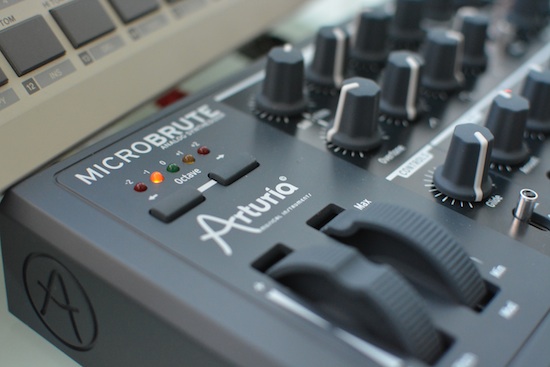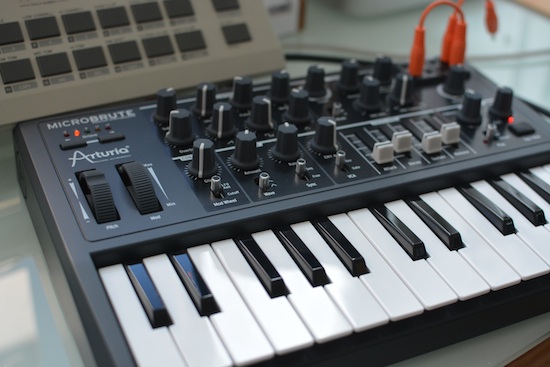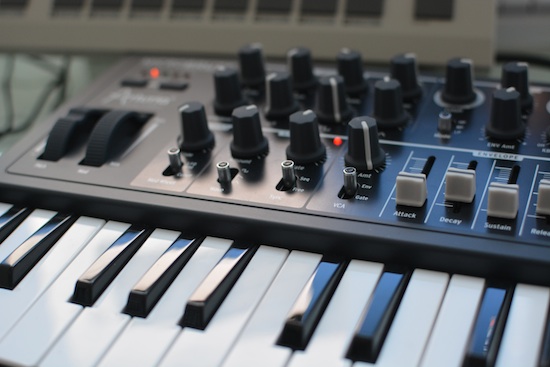Arturia MicroBrute Analog Synthesiser Review

I may as well come out and say it, if you want to hate the MicroBrute then stop reading now, I’m about to gush. Not any ordinary gush either, the kind of excitement a little kid gets when they open their first Scalextric, or their first surprise puppy. When I was a kid I loved Lego, my Mum tells me I played with it for hours just messing around and coming up with new inventions. The MicroBrute is synth Lego for musicians. If you like stuff handed to you on a plate then the MicroBrute is not for you, if you want to get lost in exploring sound and the wonderful sonic accidents you might have, then the MicroBrute is for you.
If I was President then I would make it compulsory for every musician using synths to spend a day with a MicroBrute - not many things make me smile, but the MicroBrute does. I love French wine and French cheese, now the MicroBrute is on the list too. It almost makes me able to forgive them for the appalling cars they made in the 1970s.
See, I said I was going to gush… just imagine if I worked for Arturia?
So after that over-effusive, rhapsodic introduction what else is there to say? Plenty.

MicroBrute
The MicroBrute is a micro analog (sic) synth featuring basic Sawtooth, Square, Triangle waveforms which are then further enhanced by a Steiner-Parker 2 pole Multimode Filter (Low Pass, Band Pass, High Pass), a Overtone’ sub oscillator / 5th generator as well as Pulse Width Modulation, Ultrasaw generating fat sawtooth waveforms and Metalizer bringing extreme harmonics. There’s the usual 4 part Envelope of ADSR, an assignable LFO, Mod and Pitch Bend, a sequencer and a CV mod matrix where one can route stuff just like the ‘good old days’ of synths when presets were just a pipe dream.
Using the MicroBrute takes some effort, or should I say fun - just start turning knobs and see what happens. Of course a basic understanding of subtractive synthesis is going to be a help in the long run, but there’s an excellent manual to get you up to speed.
There’s also the MicroBrute connection software that you can use via USB to add further features to the sequencer, as well as update the firmware.
In Use
I was going to make a video but the guys at Source Distribution have made such a great one you are better off watching that.
As I said in my introduction, this is serious fun but don’t let either the fun factor or the size of this baby lead you to think that the sound is anything but huge. On one hand it can create sounds that are filthier than a porn stash in a skip, to super low ‘neighbours reporting you to the council’ bass sounds.
Then there’s the sequencer that can hold 8 patterns which can either run free like a deer or can be locked to MIDI.
There’s also an audio in where you can pump anything from a drum machine, a guitar, bass, in fact whatever you fancy and use the filters to treat it. Another couple hours was lost doing this with my TR505 drum machine.

Conclusion
I could have written a much longer review, but I’m too busy having fun with the MicroBrute.
If you are in the market for a winter coat, a new car, a sofa or a PS4 then the MicroBrute is not probably a good alternative… but then again. If you are looking for a very cool real analogue synth, either as your first synth, or your twenty fifth synth, then at around £250 the MicroBrute is a no brainer.
Go find a store an play with one for as long as they will let you - no video or review is going to do this baby justice.
Sell a spare organ and buy it, it’s as simple as that.
Editors Choice Award, no argument.
